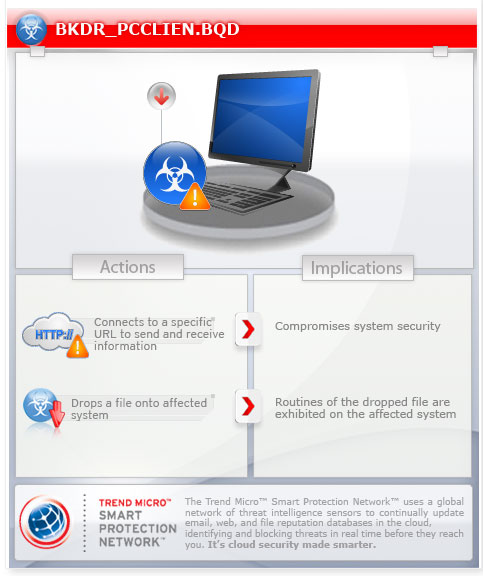BKDR_PCCLIEN.BQD
Windows 2000, Windows XP, Windows Server 2003


Threat Type: Backdoor
Destructiveness: No
Encrypted: No
In the wild: Yes
OVERVIEW
This backdoor is the dropped file of TROJ_ARTIEF.AEB, which leverages the death of North Korean leader Kim Jong-Il.
To get a one-glance comprehensive view of the behavior of this Backdoor, refer to the Threat Diagram shown below.

It connects to specific URL(s) to send and receive commands from a remote malicious user. In turn, this compromises system security.
This backdoor may be dropped by other malware.
However, as of this writing, the said sites are inaccessible.
It deletes the initially executed copy of itself.
TECHNICAL DETAILS
TCP port 8000 (iRDMI)
117,249 bytes
PE
Yes
19 Dec 2011
Compromises system security
Arrival Details
This backdoor may be dropped by the following malware:
- TROJ_ARTIEF.AEB
Installation
This backdoor drops the following component file(s):
- %Windows%\comres.dll - also detected as BKDR_PCCLIEN.BQD
(Note: %Windows% is the Windows folder, which is usually C:\Windows or C:\WINNT.)
It drops the following copies of itself into the affected system:
- %User Temp%\{Random Numbers}
(Note: %User Temp% is the current user's Temp folder, which is usually C:\Documents and Settings\{user name}\Local Settings\Temp on Windows 2000, XP, and Server 2003.)
Backdoor Routine
This backdoor opens the following port(s) where it listens for remote commands:
- TCP port 8000
It connects to the following URL(s) to send and receive commands from a remote malicious user:
- cdpcp.{BLOCKED}u.com
However, as of this writing, the said sites are inaccessible.
Other Details
This backdoor deletes the initially executed copy of itself
NOTES:
This backdoor may be instructed by the remote malicious user to download possibly malicious files.
SOLUTION
9.200
8.654.10
19 Dec 2011
8.655.00
20 Dec 2011
Step 1
For Windows XP and Windows Server 2003 users, before doing any scans, please make sure you disable System Restore to allow full scanning of your computer.
Step 3
Restart in normal mode and scan your computer with your Trend Micro product for files detected as BKDR_PCCLIEN.BQD. If the detected files have already been cleaned, deleted, or quarantined by your Trend Micro product, no further step is required. You may opt to simply delete the quarantined files. Please check this Knowledge Base page for more information.
Did this description help? Tell us how we did.


